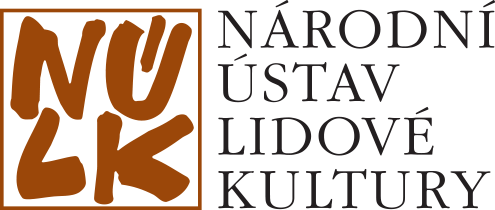A wide spectrum of visual expressions associated with culture and folk´s life. It includes the following categories: 1) Traditional folk art – it represents active expressions of folk population, whereby the producer is identical with the consumer. The folk creator works for himself/herself and his/her close neighbourhood, his/her creation was originally motivated by out-of-aesthetical impulses. Over historical times, a part of traditional art became professional, and today this category can be perceived as a replica of traditional, consciously safeguarded and spread works. – 2) Popularized art – its roots reach back to the era of stylized expression, and it is created by individuals with certain capabilities, who are trained in this activity. Their products were an integral part of folk classes´ environment in the past. Currently, this category is represented mainly by paintings on glass (replicas according to old paintings, modern production in the sense of an ideal model of traditional rural life), furniture (new production of “farmer´s” furniture), and ceramics and glass, which however renounce their practical function, while becoming more and more decorative objects. 3) Amateur art – it is represented by expressions of non-trained individuals with ambitions in visual art. After the model of stylized art, these expressions are performed in the following disciplines: drawing, graphic art, painting, plastic art (sculpture, relief) and combined technique. 4) Naive art – a special type of visual expression of non-trained persons with certain peculiar formal features; in principle, this type of art does not try to approximate to period stylized works. This category finds its expressions in drawing, painting (probably most often) and plastic art (sculpture, relief, installation). – 5) Mass and folklore kitsch – this term covers products of mass culture, which became established among popular classes. They make use of traditional visual-art values and expressions typical for folk environment, converting them into cheap substitutes (comp. especially production of souvenirs). The present-day representatives of this category include architectural decorative elements (e.g. ornamental wall paintings in the sense of folklorism, suspended wagon and cart wheels etc.), and decorative elements in interior (e.g. wall paintings), gardens (e.g. gipsy dwarfs, wheelbarrow with flowers etc.). – 6) Do-it-yourself behaviour – this behaviour features a fancy for small hand-crafting and it is widespread within a large part of population, which is supported by mass media (comp. television programmes, magazines). This activity results in different products made of wood (e.g. plywood), metal (e.g. welded decorative objects, products made in thinker´s technique etc.), and plastics (e.g. sculptures of PET bottles etc.)
Literature: K. Šourek: Lidové umění v Čechách a na Moravě [Folk Art in Bohemia and Moravia]. Praha b.r. (1940).-Československá vlastivěda III. Lidová kultura. Praha 1968, pp. 703-709.- J. Staňková: Lidové výtvarné umění. Čechy a Morava [Folk Visual Art. Bohemia and Moravia]. Praha 1967.- S. Kovačevičová: Lidové výtvarné umění. Slovensko [Folk Visual Art. Slovakia]. Praha 1974.- J. Dolejš: Naivní a insitní tvorba [Naive and In Situ Art]. Umění a řemesla 1979, Vol. 2, pp.13-27.- R. Jeřábek: Výtvarná kultura lidu (Miniterminologie) [Folk´s Visual Culture (Mini-Terminology]. Umění a řemesla 1979, Vol.2, pp.4-7.- R. Jeřábek: Výtvarná aktivita současné vesnice [Visual Activity of Present-Day Village]. Umění a řemesla, č.2, str.44-49.- J. Staňková: Lidové umění z Čech, Moravy a Slezska [Folk Art from Bohemia, Moravia, and Silesia]. Praha 1987.- R. Jeřábek: Výtvarná kultura lidu (Pokus o systematizaci lidového a zlidovělého umění) [Folk´s Visual Culture (An attempt to systemize the folk and the popularized arts]. Umění a řemesla 1989, Vol. 2, pp. 7-11.- Z. Vachová: Lidové umění výtvarné [Visal Folk Art]. In: Těšínsko 4. Šenov u Ostravy 2002, pp. 219-264.
7.1. Traditional folk art (in the form for visual folklorism, it originates in traditional materials, techniques and patterns, it reproduces traditional shapes)
7.2. Popularized art and handicrafts
7.2.1. Painting on glass
7.2.2. Furniture
7.2.3. Ceramics (utility ceramics, souvenirs)
7.2.4. Glass (souvenirs)
7.3. Amateur art
7.3.1. Drawing
7.3.2. Graphic art
7.3.3. Painting
7.3.4. Plastic art (sculptures, reliefs)
7.3.5. Combined technique
7.4. In situ (naive) art
7.4.1. Drawing
7.4.2. Painting
7.4.3. Plastic art (sculptures, reliefs, installations)
7.4.4. Combined technique
7.5. Mass production and present-day kitsch
7.5.1. Mass production with assigns of folklorism (e.g. souvenirs)
7.5.2. Decoration of buildings, interiors, gardens
7.6. Do-it-yourself behaviour
7.6.1. Products made of wood (e.g. plywood)
7.6.2. Products made of metal (e.g. products made using the thinker´s technique)
7.6.3. Products made of plastics (e.g. PET bottles)
7.6.4. Products made of textile

